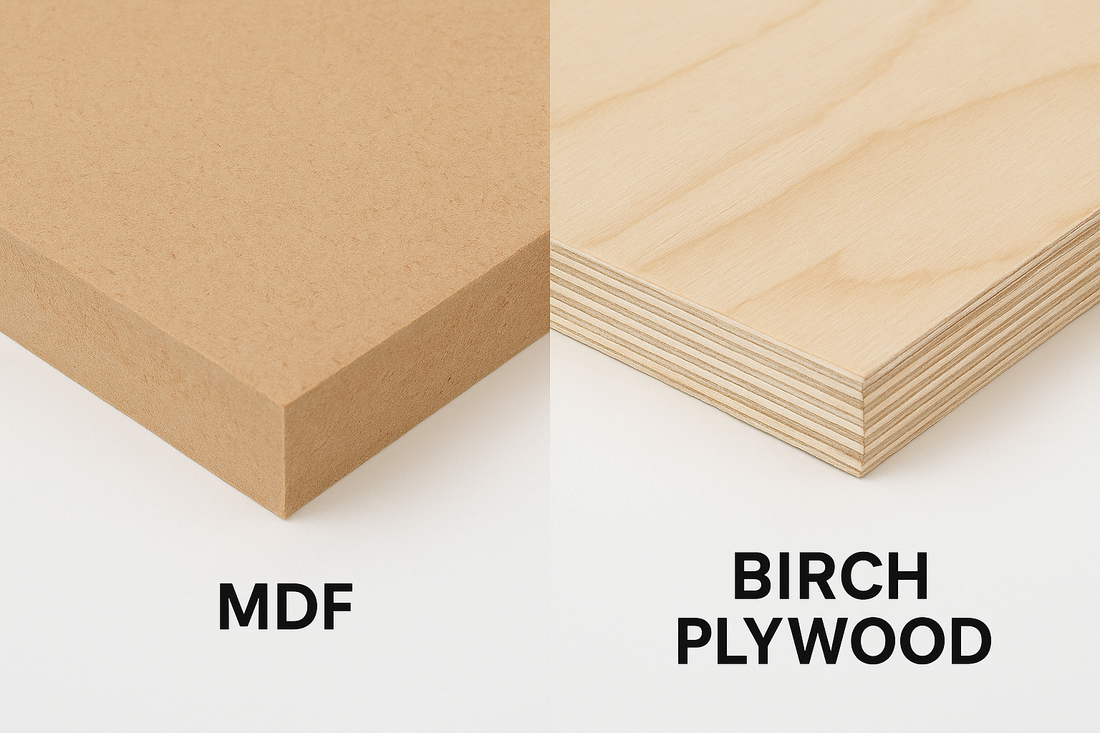
MDF vs. Birch Plywood. Sustainability, acoustics and logevity.
Share
MDF vs Birch Plywood for Loudspeaker Enclosures: Sustainability, Acoustics & Longevity
Choosing the right material for a loudspeaker cabinet is more than an aesthetic or cost decision, it affects sound, durability and the product’s environmental footprint. Recent life-cycle assessments (LCAs) and acoustic studies show there is no single “best” material: both MDF and birch plywood can be excellent choices depending on sourcing, manufacturing and intended use.
Environment: it’s about supply chain, not just material
LCAs and industry Environmental Product Declarations (EPDs) show manufacturing method, adhesive type and transport dominate carbon and energy impacts. Industry-average EPDs for North American MDF and softwood plywood are publicly available and show overlapping ranges of global warming potential depending on scope and biogenic carbon accounting. See the Composite Panel Association / AWC MDF EPD and the North American softwood plywood EPD for detailed cradle-to-gate figures:
- CORRIM — Cradle-to-grave LCA of MDF (PDF).
- AWC/CPA — MDF Environmental Product Declaration (PDF).
- AWC — North American Softwood Plywood EPD (PDF).
Bottom line: plywood often shows lower manufacturing impacts per m³ when sustainably sourced and when biogenic carbon storage is counted, while MDF can be competitive where it uses high shares of residues, low-carbon energy or low-emission binders. Transport distance and adhesive chemistry (urea vs phenolic vs MDI/bio-resins) are decisive.
Acoustics: density (MDF) vs stiffness (plywood)
Acoustic studies and modeling show MDF’s high density and internal damping reduce resonance amplitudes, making it forgiving in mid-size sealed cabinets. Birch plywood offers a higher stiffness-to-weight ratio, shifting panel modes upward and enabling lighter builds with fewer low-order vibrations. A representative analysis of cabinet radiation and material behavior can be found in COMSOL-based studies and AES literature; for plywood manufacturing impacts see Jia et al. (2019):
Practical approach used by many designers: hybrid construction: plywood for structural panels ("bracing") and baffle, MDF for inner panels and finish, combining stiffness, damping and finishability.
Durability & climate resilience
Plywood’s cross-laminated veneers give superior dimensional stability, screw retention and resistance to humidity cycles. MDF swells at cut edges if not sealed and can degrade under repeated moisture/temperature changes; moisture-resistant (MR/HMR) MDF grades exist but cost more. For portable or stage gear, plywood (e.g., birch multi-ply) typically wins on lifetime and repairability.
Adhesives, emissions and indoor air
Adhesive type matters: urea-formaldehyde (common in MDF) can emit formaldehyde, while phenol-formaldehyde (used in exterior plywood) tends to have lower free formaldehyde. Specify E0/E1 or MDI/bio-resin panels when IAQ and low embodied fossil carbon are priorities. Industry EPDs and CORRIM reports detail these hotspots.
Cost & manufacturing
MDF is typically cheaper and easier to machine and finish, a favorite for painted hi-fi cabinets. Birch plywood costs more up front but reduces weight and improves durability for pro audio and portable systems. Over a product’s life, plywood can be more cost-effective where repair, transport and longevity matter.
Conclusions & practical guidance
Both MDF and birch plywood are valid, sustainable choices for loudspeakers, what matters most are:
- Raw-material sourcing (FSC/PEFC certification);
- Adhesive chemistry (low formaldehyde or bio-based binders);
- Manufacturing energy mix and efficiency; and
- Transport distance and product lifetime (durability & reuse).
If you want longevity and moisture resistance (portable/pro use): choose FSC-certified birch plywood (structural panels and baffles).
If you want low cost and a flawless painted finish for indoor hi-fi: choose E0/E1 MDF with carefully sealed edges and robust internal bracing. Or use a hybrid: plywood for structure, MDF for finishing panels.
References (select PDFs & peer-reviewed paper)
- CORRIM. Cradle-to-grave Life Cycle Assessment of North American MDF. PDF: corrim.org/MDF-LCA (PDF).
- AWC / CPA. Medium Density Fiberboard — Environmental Product Declaration. PDF: AWC-EPD-MDF (PDF).
- AWC / CWC. North American Softwood Plywood — EPD. PDF: AWC-Plywood-EPD (PDF).
- Jia, L. et al. “Life Cycle Assessment of Plywood Manufacturing Process” (2019). Int. J. Environ. Res. Public Health. Peer-reviewed article: mdpi.com/1660-4601/16/11/2037.



